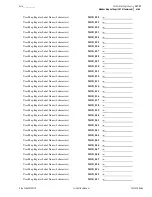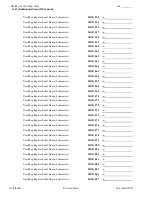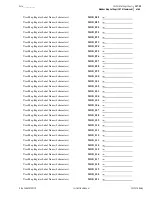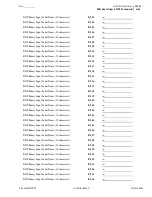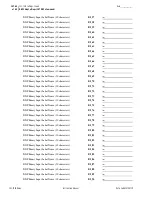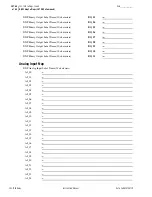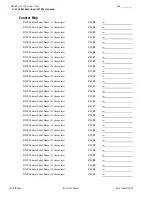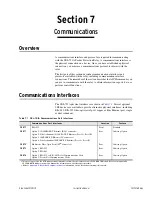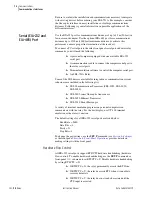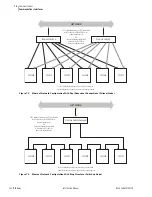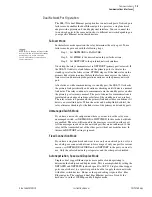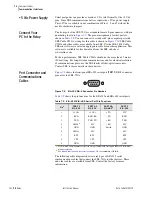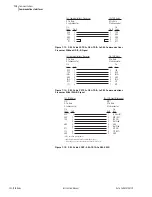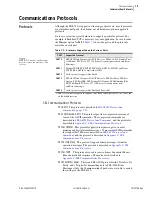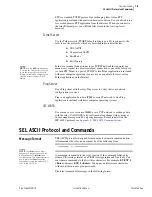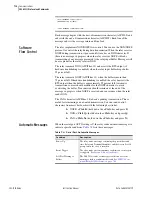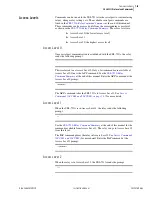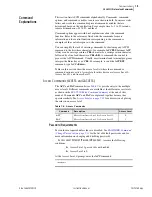
7.2
SEL-751A Relay
Instruction Manual
Date Code 20100129
Communications
Communications Interfaces
Be sure to evaluate the installation and communications necessary to integrate
with existing devices before ordering your SEL-751A. For example, consider
the fiber-optic interface in noisy installations or for large communications
distances. Following is general information on possible applications of the
different interfaces.
Serial (EIA-232 and
EIA-485) Port
Use the EIA-232 port for communications distances of up to 15 m (50 feet) in
low noise environment. Use the optional EIA-485 port for communications
distances up to 1200 m (4000 feet) maximum distance (to achieve this
performance, ensure proper line termination at the receiver).
To connect a PC serial port to the relay front-panel serial port and enter relay
commands, you will need the following:
➤
A personal computer equipped with one available EIA-232
serial port
➤
A communications cable to connect the computer serial port to
the relay serial ports
➤
Terminal emulation software to control the computer serial port
➤
An SEL-751A Relay
Some of the SEL devices available for integration or communication system
robustness are included in the following list:
➤
SEL Communications Processors (SEL-2032, SEL-2030,
SEL-2020)
➤
SEL-2800 series fiber-optic transceivers
➤
SEL-2890 Ethernet Transceiver
➤
SEL-3010 Event Messenger
A variety of terminal emulation programs on personal computers can
communicate with the relay. For the best display, use VT-100 terminal
emulation or the closest variation.
The default settings for all EIA-232 serial ports are listed below:
Baud Rate = 9600
Data Bits = 8
Parity = N
Stop Bits = 1
To change the port settings, use the
SET P
command (see
Section 8: Front-Panel Operations
provides details on
making settings with the front panel.
Hardware Flow Control
All EIA-232 serial ports support RTS/CTS hardware handshaking (hardware
flow control). To enable hardware handshaking, use the
SET P
command or
front-panel
PORT
submenu to set RTSCTS = Y. Disable hardware handshaking
by setting RTSCTS := N.
➤
If RTSCTS := N, the relay permanently asserts the RTS line.
➤
If RTSCTS := Y, the relay deasserts RTS when it is unable to
receive characters.
➤
If RTSCTS := Y, the relay does not send characters until the
CTS input is asserted.
Summary of Contents for 751A
Page 1: ...20100129 SEL 751A Feeder Protection Relay Instruction Manual PM751A 01 NB...
Page 6: ...This page intentionally left blank...
Page 12: ...This page intentionally left blank...
Page 18: ...This page intentionally left blank...
Page 26: ...This page intentionally left blank...
Page 92: ...This page intentionally left blank...
Page 218: ...This page intentionally left blank...
Page 250: ...This page intentionally left blank...
Page 376: ...This page intentionally left blank...
Page 392: ...This page intentionally left blank...
Page 408: ...This page intentionally left blank...
Page 418: ...This page intentionally left blank...
Page 434: ...This page intentionally left blank...
Page 462: ...This page intentionally left blank...
Page 544: ...This page intentionally left blank...
Page 580: ...This page intentionally left blank...
Page 584: ...This page intentionally left blank...
Page 632: ...This page intentionally left blank...
Page 636: ...This page intentionally left blank...
Page 640: ...This page intentionally left blank...


